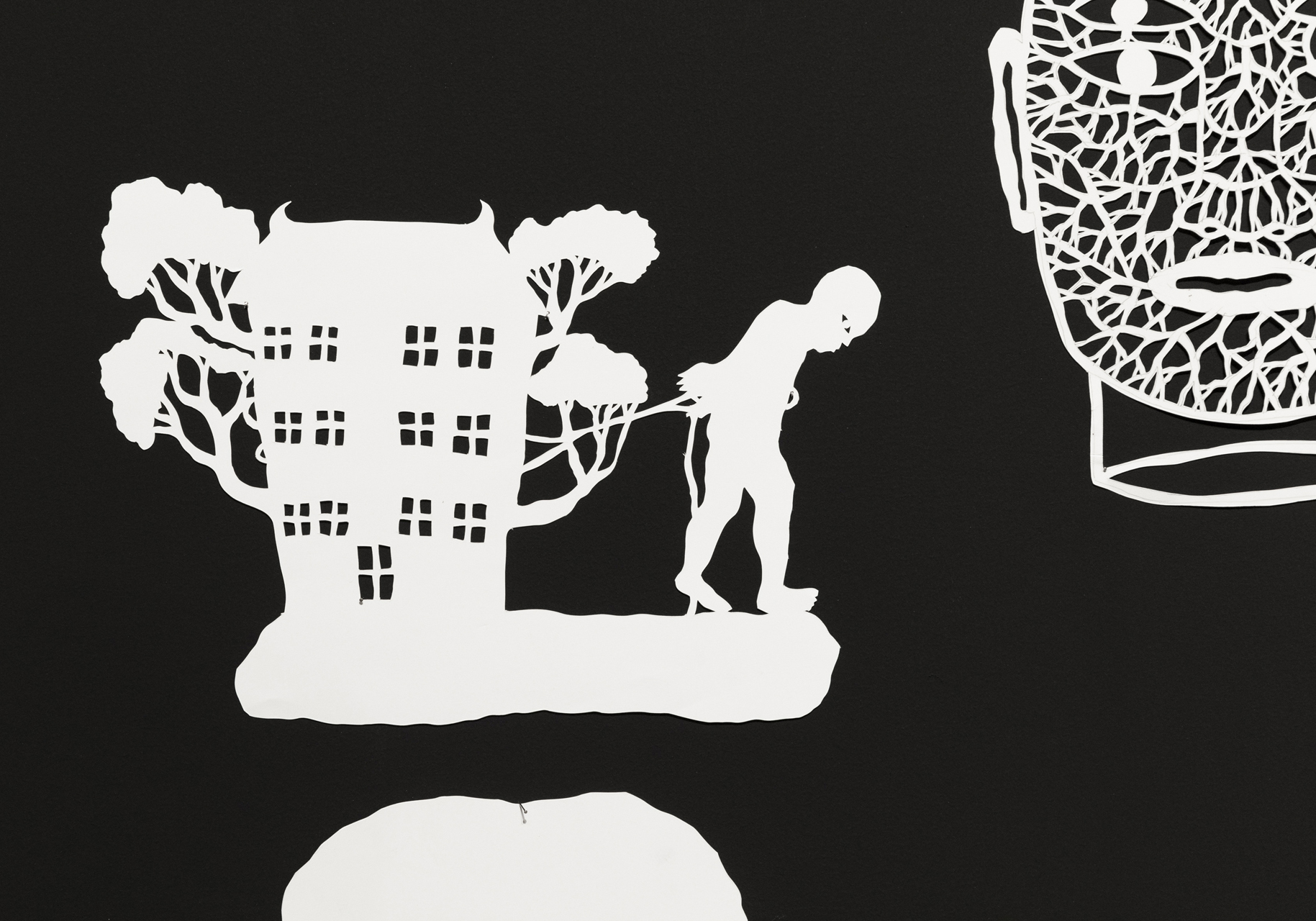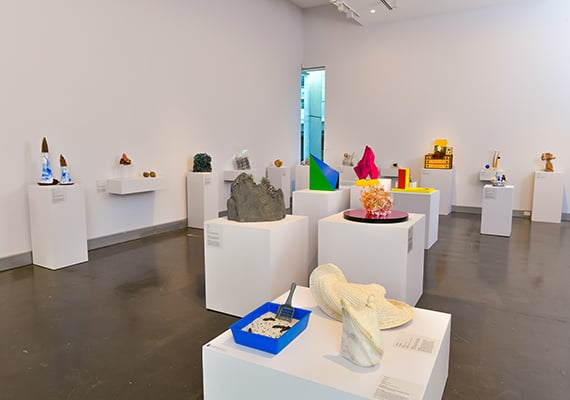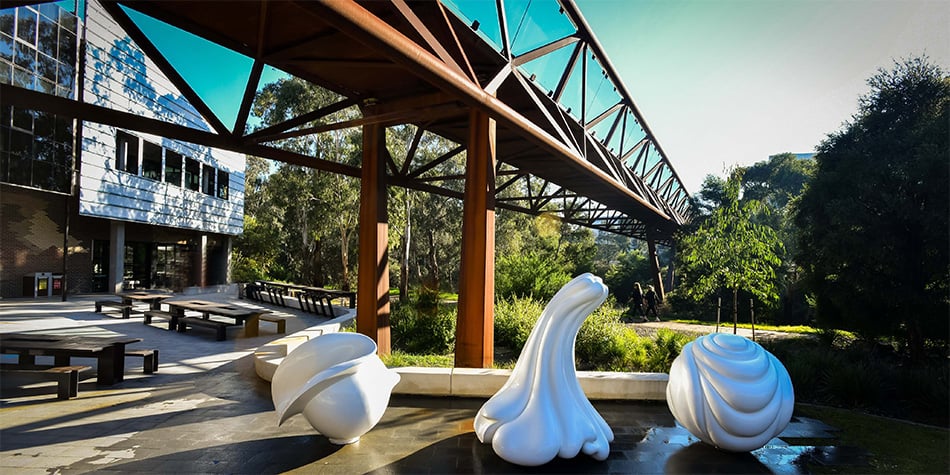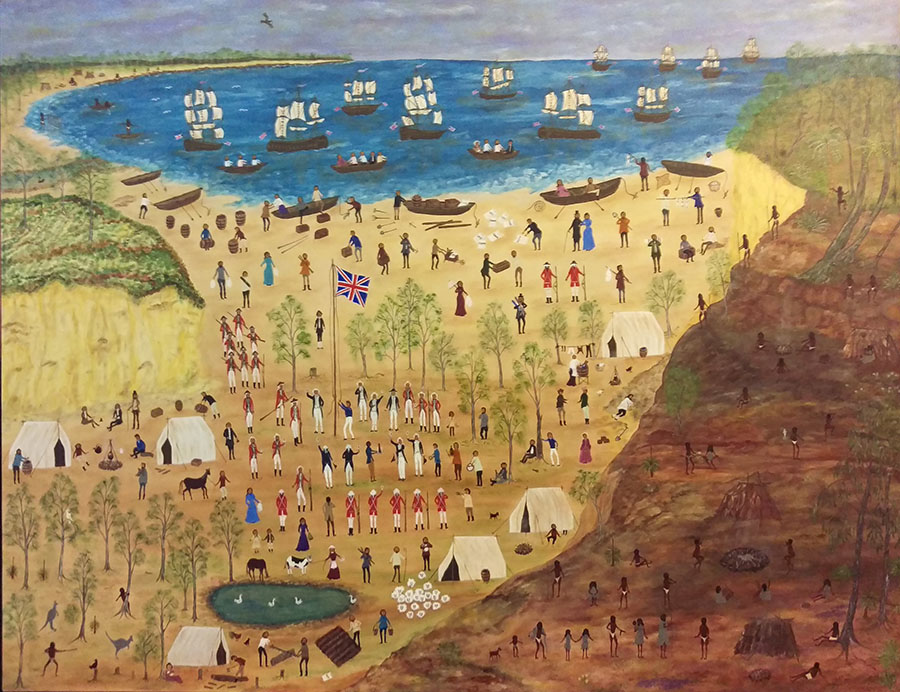Upcoming exhibitions
Exhibitions are primarily held at the Deakin University Art Gallery, Melbourne Burwood Campus and at Deakin University gallery spaces across our campuses. Please click on the below link to see our upcoming exhibitions.
Past exhibitions
Please click on the below link to find a selection of past exhibitions, including immersive virtual tours.
Jumaadi: the unaccounted sea
17 April – 14 June 2024

Image: Jumaadi, Joli-Jolan 2022 (detail), paper cut-outs, dimensions variable, installation view as part of The National 4, Campbelltown Art Centre, Sydney 2023, © and courtesy of the artist and King Street Gallery on William, Sydney, photo by Silversalt Photography.
Jumaadi is an Indonesian/Australian artist who lives both in Sydney and Yogyakarta and works fluidly across painting, drawing, paper cuts, buffalo hide, performance, animation and installation. Jumaadi's Indigenous Javanese heritage informs his practice, as well as his personal experiences and the colonial and political histories of his homeland. Recent works and performances have addressed passages of water and those whose journeys depend on it. With a poetic sensibility and symbolism, Jumaadi weaves together personal iconographies of human and organic motifs exploring themes of place, conflict and belonging.
Virtual tour artwork labels
From left clockwise around gallery
Jumaadi
Joli Jolan 2022
paper cuts, dimensions variable
© and courtesy of the artist and King Street Gallery on William, Sydney
This large artwork began during the pandemic periods of lockdown and was first included in the exhibition Superfluous Things: Paper at the Singapore Art Museum (2022). The project was further expanded for The National 4 exhibition at Campbelltown Arts Centre, Sydney (2023) and now consists of over 300 hundred intricate white paper cut-outs presented on a painted black wall with each individual work telling its own story. Here, Jumaadi reverses traditions of shadow puppetry where a play of light creates dark forms on a lit background. The title Joli Jolan is derived from the Javanese term ijol ijolan meaning to swap, to trade and to exchange things. In this major work we can glimpse the artist’s world view: a grand lexicon of migration and movement of people and things over a great expanse. Across three sections, the work considers the unbalanced exchange between humans, animals and nature. Trees and natural forms including rocks, roots and branches, as well as, bodies, agricultural animals, farming tools, ropes, chairs, carts and an assembly of characters, figures and ships – of all shapes and descriptions, are carrying things and are on the move in a mass formation. Jumaadi’s figures push, pull, lift and endure labouring under perpetual forces and burden. Jumaadi focuses on representations of creative adaptation and resilience conveying the energy and strength of common people under forced displacement and their struggles amidst the difficult challenges of daily life.
Wayang
The term wayang derives from the Javanese word wewayangan meaning ‘shadow’ or ‘imagination’ with the equivalent word in Bahasa being bayang. In modern daily usage wayang refers both to the Indonesian tradition of shadow puppetry which originated in Java, to the puppet itself and to the whole ritual of the puppet theatre performance including the singers, narrators and musicians. Wayang kulit is the most well-known and unique form of puppetry theatre employing light and shadow. The puppets are crafted from cut buffalo hide mounted on bamboo sticks which when held up behind a piece of white cloth, with a light source, shadows are cast on the screen creating animated characters. Wayang performances are usually held to mark certain times of the year, important ceremonies and events such as Indonesian Independence Day. Traditionally, wayang is played out in a ritualised midnight to dawn performances led by an artist or spiritual leader with the audience watching from both sides of the screen. Jumaadi often employs the wayang tradition using buffalo hide, or more commonly found materials such as white office paper or flattened tin to create cut out artworks representing figures, characters and or elements of the natural world in transformation.
Jumaadi
Untitled 2024
white chalk drawing
© and courtesy of the artist and King Street Gallery on William, Sydney
Jumaadi
Skak 2022
synthetic polymer paint on primed unstretched calico
© and courtesy of the artist and King Street Gallery on William, Sydney
Skak translates in Bali Bahasa to mean chess and this painting depicts a pair of figures seated at a chess board. One is a local Indonesian, and the other is dressed in the uniform of the Dutch colonial army. Together they are playing on a board made up of abundant vegetation with pieces made from nails in an exchange of resources and power. The figures are placed in a stage like setting surrounded by a frame of green mountains. Jumaadi was inspired by the Ludruk theatre of the 1930s from Surabaya, East Java, which often depicted colonial era stories as a method of political opposition through art.[3] In this painting however, nature is slowly taking over with a series of tree like root forms growing through the tiled floor.
Jumaadi
After the Forest 2022
synthetic polymer paint on primed unstretched calico
© and courtesy of the artist and King Street Gallery on William, Sydney
In this painting a mass migration of tree stumps has seemingly uprooted themselves and are on the move, with each tree stump brandishing a seeing eye. Jumaadi’s painting considers the issue of deforestation caused by the production and export of palm oil and asks the question, who is watching while precious natural resources are moved, consumed and exhausted, and who profits from this trade?
Kamasan Painting
Jumaadi’s recent paintings are inspired by the Balinese Kamasan painting tradition. This highly unique Indigenous cultural practice was the dominant form of pictorial representation in Bali until the 20th century. In this process, cotton cloth is primed and sealed with a glue paste made from rice, rubbed by hand to create a smooth surface like paper, and were then painted using natural pigments sourced from local plants and minerals. This tradition originates from the Kamasan village in East Bali that was once part of Klungklung kingdom. One of the oldest kingdoms on the island, Klungklung witnessed the flourishing of art forms, under the patronage of the royal court during the reign of the Gelgel dynasty in the 16th century. Historically, Kamasan paintings were folded and stored and were displayed to help create environments for important religious ceremonies. The subjects of Kamasan painting are usually grand religious and epic mythical stories from the Ramayana and Mahabarata depicting battle scenes and events.
Exhibition catalogues
Interactive catalogues for our exhibitions are available via Issuu.
Deakin University Contemporary Small Sculpture Award
The Deakin University Contemporary Small Sculpture Award is an annual competition showcasing outstanding sculptures from artists across Australia.

Image: Installation image of the 2023 Deakin University Contemporary Small Sculpture Award, Deakin University Art Gallery, August 2023, photography Simon Peter Fox.
Supported by the Community Bank at Deakin University

Learn more about the Deakin University Contemporary Small Sculpture Award
Education and public programs
Public programs at Deakin University Art Gallery include floor talks, panel presentations and seminars. We also offer education programs for schools and community groups that feature guided exhibition and collection tours, behind-the-scenes presentations and hands-on workshops.
School programs
The Deakin University Art Gallery offers a range of vibrant and diverse education programs based on current exhibitions and the art collection. All programs are free of charge and can be tailored to suit your schools' needs and/or interests.
Learn more about our school programs
Community group programs and guided tours
We offer a range of different options for community groups, including outreach programs based around the Deakin University Art Collection. Contact us with your requirements and we can tailor a session for your group or arrange a guided tour.
Self-guided tours
For self-guided tours, download one of our free art collection (Deakin Downtown and Warrnambool Campus) or Sculpture Walk guides (Melbourne Burwood, Geelong Waurn Ponds and Geelong Waterfront campuses).
Deakin Downtown art collection guide
Warrnambool Campus art collection guide
Melbourne Burwood Campus Sculpture Walk guide
Stay up to date
If you would like to be added to our mailing list, please register you details.
Deakin University Art Collection
The Deakin University Art Collection is a unique and treasured collection of contemporary artworks by some of Australia’s leading artists. The collection reflects the cultural aspirations of Deakin and plays a significant role in creating a welcoming environment on campus, enriching the experience of university life and contributing to philosophical inquiry and creative research.
The collection first came together with artworks from Deakin University’s antecedent institutional collections including the Victoria State Teachers College, Prahran College of Advanced Education, the Douglas McDonnell and others. It now consists of approximately 2400 artworks by over 900 artists.
The collection is comprised of examples of innovative creative practices including achievements in painting, sculpture, print, drawing, ceramic, photography, textiles and includes one of Australia’s largest holdings of artist books. Importantly, it is home to cherished artworks by First Peoples, including many artists that are based in South-Eastern Australia. It also houses artworks by our past and present students and staff, telling a special story of the Deakin University origins and its community.
A selection of important works in the collection are by artists such as: Hoda Afshar, George Baldessin, Gordon Bennett, Uncle Jim Berg, Ronald Bull, Arthur Boyd, Stephen Bram, Maree Clarke, John Cato, Vicki Couzens, Mikala Dwyer, Fayen d’Evie, Robert Fielding, Emily Floyd, Sally Gabori, Simyrn Gill, Aunty Marlene Gilson, Elizabeth Gower, Inge King, Robert Klippel, Hayley Millar-Baker, Sidney Nolan, Lin Onus, John Olsen, Robert Rooney, Mike Parr, Kerrie Poliness, The Ken Sisters, Jenny Watson, Ron Robertson-Swann and Fred Williams among many others.
Maintaining and developing this collection demonstrates the University’s ongoing interest in the study, patronage and advancement of the visual arts in Australia. Acquisition highlights can often be found through our social media.
We are always happy to consider donations from artists and collectors as direct donations or through the Australian Government Cultural Gifts Program, please email us for more information. If you have a research or collection enquiry, please contact the Art Gallery team.
Management of personal information
Deakin University manages personal information it holds, including requests by individuals for access to their personal information, in accordance with the Privacy and Data Protection Act 2014 (Vic). Individuals have a right to gain access to their personal information held by the University. Further information about privacy at Deakin may be obtained by contacting the Privacy Officer at (03) 5227 8524 or at privacy@deakin.edu.au.
Personal information of artists
This statement outlines how Deakin University handles the personal information of artists whose works are held by the Deakin University Art Gallery.
Purpose of collection
Deakin University collects an artist's personal information for the primary purposes of acquisition of an artwork, management and maintenance of the University's art collection and for the purposes of exhibiting, interpreting and promoting the artwork, the artist and the Art Collection.
Means of collection
Deakin may collect personal information from the artist directly during interactions with Deakin staff, most often staff of the Art Collection and Galleries Unit. Deakin may also collect personal information from third parties (e.g., artists' agents, owners of artwork, other gallery owners) or publicly available print or online resources.
Use and disclosure
An artist's personal information may be used by the Art Collection and Galleries Unit in preparation of interpretive materials, catalogues and promotional materials, all of which may be in print or online format. For these purposes, an artist's personal information may also be used by other operational units of Deakin (e.g., its Marketing Division)
Contact details
Parking
Parking is available at Melbourne Burwood Campus. You can buy hourly or daily parking permits by using the CellOPass parking app. Download the CellOPass parking app in the Google Play store or the App Store.
Find out more about parking at Deakin
Visit us
The gallery is open Monday–Friday, 10am – 4pm, during scheduled exhibition dates (closed public holidays).
Cost: Free entry
Deakin University Art Gallery
Building FA
Melbourne Burwood Campus
221 Burwood Highway
Burwood, VIC 3125
To find the gallery on campus, enter Deakin University via Entrance 1, (Holland Avenue), off Burwood Highway. Continue straight for 500 metres. As you pass the overhead foot bridge, the gallery is on your right. If arriving by car, you can park in any of the bays on the left of Holland Avenue. Alternatively, follow Holland Avenue all the way around to the second parking entrance.
Footnotes
Banner image: Adrian Mauriks, ‘Strange Fruit 2010’, painted epoxy resin, 235 x 700 x 200cm. Deakin University Art Collection. Gift of the artist, 2020. Photography Simon Peter Fox. Image courtesy the artist estate. Pictured in situ at the Melbourne Campus at Burwood.
Discover more
Contact us
Contact us with any enquiries. Or register to our mailing list and follow the Deakin Art Gallery on social media to stay up to date with the latest news.
+61 3 9244 5344
Email Deakin Art Gallery
Facebook @ArtDeakin
Instagram @deakinartgallery
Twitter @ArtDeakin


